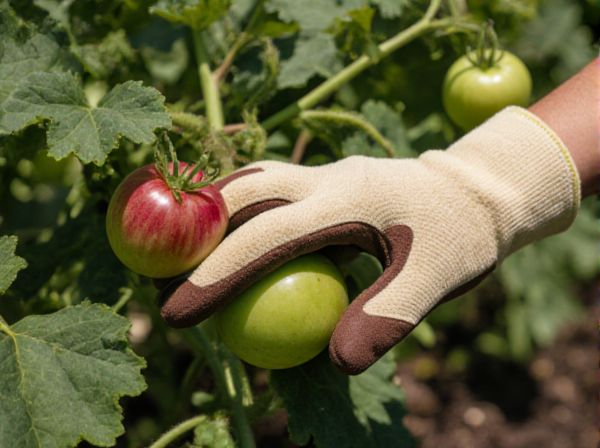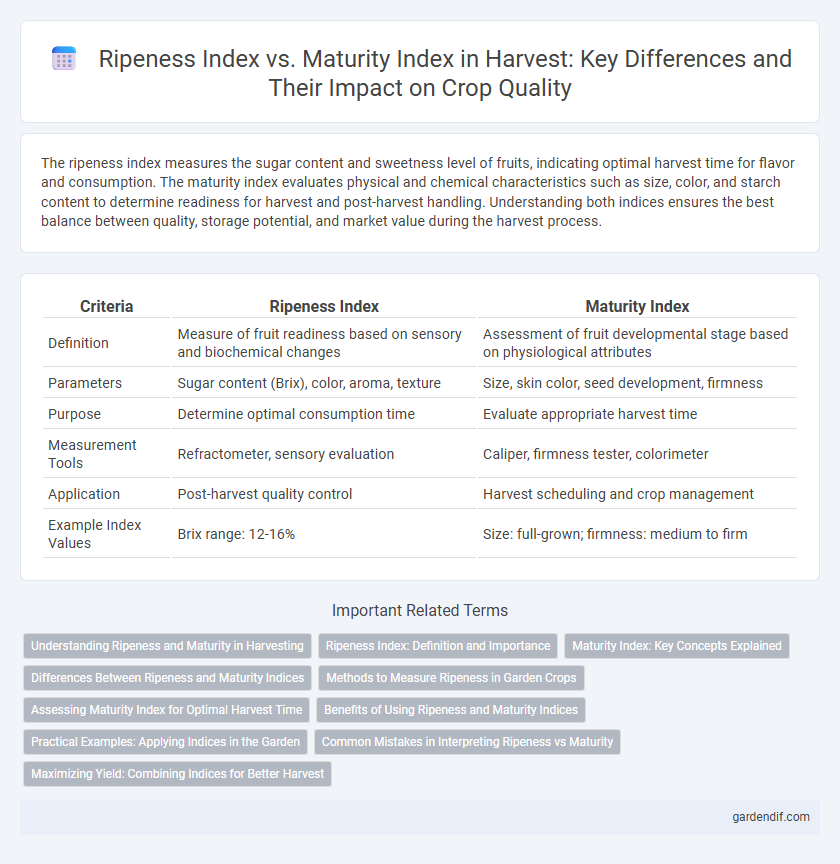
Ripeness index vs maturity index Illustration
The ripeness index measures the sugar content and sweetness level of fruits, indicating optimal harvest time for flavor and consumption. The maturity index evaluates physical and chemical characteristics such as size, color, and starch content to determine readiness for harvest and post-harvest handling. Understanding both indices ensures the best balance between quality, storage potential, and market value during the harvest process.
Table of Comparison
| Criteria | Ripeness Index | Maturity Index |
|---|---|---|
| Definition | Measure of fruit readiness based on sensory and biochemical changes | Assessment of fruit developmental stage based on physiological attributes |
| Parameters | Sugar content (Brix), color, aroma, texture | Size, skin color, seed development, firmness |
| Purpose | Determine optimal consumption time | Evaluate appropriate harvest time |
| Measurement Tools | Refractometer, sensory evaluation | Caliper, firmness tester, colorimeter |
| Application | Post-harvest quality control | Harvest scheduling and crop management |
| Example Index Values | Brix range: 12-16% | Size: full-grown; firmness: medium to firm |
Understanding Ripeness and Maturity in Harvesting
Ripeness index measures the biochemical changes in fruit, such as sugar content and acidity, indicating optimal flavor and eating quality at harvest. Maturity index assesses physical development parameters like size, color, and firmness, reflecting the fruit's readiness for harvest and post-harvest handling. Understanding the differences between ripeness and maturity indices ensures precise timing in harvesting, optimizing crop value and reducing post-harvest losses.
Ripeness Index: Definition and Importance
Ripeness Index measures the optimal stage of fruit readiness based on sugar content, acidity, and texture, providing precise indicators for harvesting decisions. It plays a critical role in ensuring optimal flavor, nutritional quality, and shelf-life of harvested crops. Accurate assessment of Ripeness Index supports maximizing yield value and reducing post-harvest losses in agricultural production.
Maturity Index: Key Concepts Explained
Maturity index measures fruit readiness by evaluating physiological indicators such as sugar content, acidity, and firmness, providing a precise standard for optimal harvest time. Unlike the ripeness index, which mainly assesses external appearance and color, the maturity index offers a comprehensive assessment of internal quality factors critical for taste, texture, and shelf life. Understanding key metrics like Brix value and firmness allows producers to maximize post-harvest quality and market value.
Differences Between Ripeness and Maturity Indices
Ripeness index measures the biochemical and sensory qualities of fruit, such as sugar content, firmness, and color, indicating optimal harvest time for consumption. Maturity index evaluates the physiological development stage of fruit, including size, weight, and days from flowering, determining suitability for long-term storage and processing. The key difference lies in ripeness focusing on immediate edibility, while maturity assesses developmental readiness for harvest and post-harvest handling.
Methods to Measure Ripeness in Garden Crops
The ripeness index measures sugar content and flavor quality, often assessed using refractometers to determine Brix levels in garden crops. The maturity index evaluates physiological development stages, using firmness tests and color charts to identify optimal harvest times. Combining these methods ensures accurate determination of harvest readiness, improving crop quality and yield.
Assessing Maturity Index for Optimal Harvest Time
Maturity index is a critical metric for determining the optimal harvest time, as it measures physiological and biochemical changes in fruit that directly correlate with ripeness and quality. Unlike the ripeness index, which primarily reflects external characteristics such as color and firmness, the maturity index incorporates internal factors like sugar content, acidity, and starch conversion. Accurate assessment of the maturity index ensures peak flavor, texture, and nutritional value, maximizing marketability and reducing post-harvest losses.
Benefits of Using Ripeness and Maturity Indices
Ripeness and maturity indices provide precise measurements of fruit development, enabling optimal harvest timing to maximize quality and shelf life. Using these indices reduces waste by ensuring fruits are harvested neither underripe nor overripe, improving marketability and consumer satisfaction. Incorporating ripeness and maturity indices into harvest protocols enhances yield prediction accuracy and supports consistent product standards across supply chains.
Practical Examples: Applying Indices in the Garden
The ripeness index measures fruit readiness based on color, texture, and sugar content, while the maturity index assesses growth stage and firmness for harvesting timing. In practical garden applications, tomatoes are often evaluated using the ripeness index by checking skin color and sugar levels, whereas melons rely on the maturity index, monitoring firmness and ground spot color. Employing these indices ensures optimal harvest quality, maximizing flavor and shelf life in homegrown produce.
Common Mistakes in Interpreting Ripeness vs Maturity
Common mistakes in interpreting ripeness versus maturity indexes often stem from confusing biochemical changes with physical indicators, as ripeness focuses on sugar content and acidity, while maturity emphasizes developmental stage and seed hardness. Farmers may rely solely on color or firmness, overlooking essential chemical parameters like soluble solids concentration or pH levels that determine optimal harvest time. Accurate assessment requires integrating both indexes using refractometers and sensory evaluations to avoid premature or delayed harvesting, which impacts crop quality and yield.
Maximizing Yield: Combining Indices for Better Harvest
Maximizing yield requires integrating the ripeness index, which measures fruit color and sugar content, with the maturity index that assesses physiological maturity through parameters like firmness and starch breakdown. Combining these indices provides a comprehensive understanding of optimal harvest timing, ensuring peak flavor and extended shelf life. This dual approach enhances decision-making, reducing post-harvest losses and improving overall crop quality.
Ripeness index vs maturity index Infographic

 gardendif.com
gardendif.com